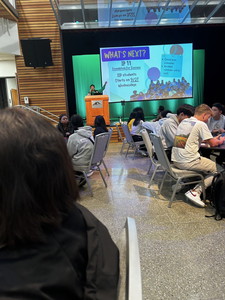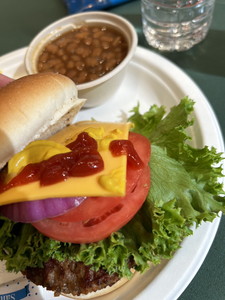

Fall Quarter Orientation
First Lunch at GRC!
Preparation
To Get a
Passport and Student Visa
You can get your passport by clerical procedures at the nearest city office
from your house in about 2 weeks. You need to go to the American
Embassy in Tokyo to get a student visa by yourself after applying for it.
You will turn in your fingerprint and take an interview in English at
the embassy, but the interview will not be that difficult. An officer will
just ask you why you would like to go to the U.S.
Even if you are
concerned about your English skills, please don't worry!!
The officers
also deal with the task in Japanese, so there is nothing to worry
about!
Things You Should Bring
Please make sure you bring
your
passport,
student visa, credit card (connected to your bank in Japan), ticket for the
bullet train, boarding pass (round trip), and some cash to deposit at Bank of America (a
bank you may use in the U.S.).
In my case, I didn't use cash except
for the rent for the host family.
If
you have a credit card, you can get almost
everything there. It is very important to be careful so as not to use your
cards too much because you must be surprised when you check your bills and balance
in your bank account ....
As
I wrote above, you can buy whatever you
want and need in the U.S. if you have enough money. (Prices are getting higher and
higher in the U.S. due to the appreciation of the dollar against the yen,
though.)
You can do online shopping with Amazon as well, so it will be
fine even if you forget to bring something from Japan.
They have Daiso, Uwajimaya (a
grocery store selling many Japanese products), and UNIQLO in Seattle.
|
Things to Bring |
Memo |
| passport/ student visa/tickets | It must
be convenient for you to use a case for your passport that you
can wear around your neck. You can get the
case at MUJI
.
Be careful not to lose the document on which the airplanes you get on are written during the stay because you need the paper when you go back from the U.S.! I recommend that you print out the document in advance, and keep it safe. |
| credit card/American dollar/Japanese yen | These are also important and you should be careful so as not to lose.
I brought some Japanese cash (about 10,000 yen ) for when I return. |
| mobile phone/PC | We submit most of our assignments on PC. You should go to the computer help desk in Seiryo and get your PC checked beforehand. |
| adapters/charger | Don't forget to bring chargers for your phone and PC! I didn't bring a transformer, but I was not in trouble. I guess it's not necessary. |
| clothes | You can buy good enough clothes in the U.S.! It was so cold in Seattle that I wore a jacket even in September. I recommend bringing some jackets, such as hoodies or down jackets . Also, it is better to bring some exercise wear for when you use the gym in GRC. I am very sensitive to cold, so I used Extra Warm Heat Tech by UNIQLO many times. There is a UNIQLO store in Seattle, but all products are more expensive than those in Japan. If you are sensitive to cold, you should bring such clothes from Japan! |
| cosmetics/skincare & haircare products | I recommend bringing Japanese
products if you know what is good for
your skin. I had a skin problem in the U.S. If you use something medical
for your skin, you should bring it! I bought shampoo and conditioner in the U.S., but I brought hair milk and oil from Japan because I heard those products are better in Japan. I got a hairdryer handed over from my friend. Some people brought their own from their countries, and others bought hairdryers in the U.S. If you are not picky about the hairdryer, you don't have to bring it. |
| souvernirs from Japan | I brought snacks and
specialties from Niigata, such as rice crackers, spoons made in Tsubame, Koshihikari
rice, and so on. Souvenirs can be a hot topic for conversations when you
talk with your friends and host family, so I recommend you bring
something only from Japan. If you have a chance, you can ask your host family what souvenir they want from Japan. |
| sub bag (tote-bag) | It is very convenient when you go out for a bit and when you put souvenirs that you bought together. |
| ear plugs (compatible with atmospheric pressure fluctuations) | I got my ears popped from the air pressure after I rode on an airplane. I felt pain in my ears and couldn't hear well for several hours. If you are sensitive to changes in atmospheric pressure, you should bring ear plugs that are compatible with atmospheric pressure fluctuations. You can buy them for only 100 yen at Daiso in Japan!! |
| tissues/wet tissues | I couldn't find similar tissues sold in Japan in
the U.S. It will be good to bring some boxes of tissues
in your suit case. Also, alcohol wet tissues are very convenient at times. |
| medicines | I brought some pills and medicines that I usually
take in Japan. You cannot let your family send you any medicine from Japan to the U.S. If you have some prescribed medicine, you should ask your doctor to prescribe enough medicine for the term you stay abroad. |
| glasses/contact lens | If you have bad eyesight, don't forget to bring your glasses (or contact lenses) ! |
| sanitary items | Painkiller and liner are so
convenient! You can get sanitary napkins in the U.S. (Japanese ones are good for sure, but American ones are no problem! ) You can use sanitary napkins in GRC for free. |
| heat packs | Surprisingly, heat packs are not sold in the U.S.!! If you are sensitive to cold, you should bring some heat packs from Japan. It's colder in Seattle than you think. |
| laundry net | You will wear sweaters and knitted clothes in the winter season, and you should use a laundry net when you wash them. I recommend the net, which is compatible with both washers and dryers. |
| folding umbrella | In Seattle, it rains a lot in the fall and winter. An umbrella is a MUST! |
The Orientation of the Fall Quarter
The next day I arrived in Seattle,
I took part in an orientation for the fall quarter at GRC. Teachers explained
the policy of GRC and student life.
I had lunch with friends who
I met during the orientation together.
 |
 |
|
Fall Quarter Orientation |
First Lunch at GRC! |